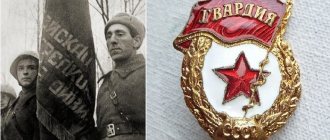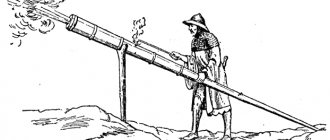May 2022 is approaching and the next anniversary of the Victory - a great holiday “with tears in our eyes.” A military parade, the passage of members of the “Immortal Regiment” and the distribution of St. George ribbons. This process, which began in 2005 on the initiative of RIA Novosti, will again be accompanied by a clash of two extremes. On the one hand, there are enthusiastic reports about the distribution of hundreds of thousands, even millions, of ribbons to the citizens of the country. On the other hand, there is malice and condemnation of the ongoing action with elements of another shift in history in a convenient direction.
The army of ribbon opponents is very diverse. From a fiery fighter against privileges in the era of perestroika, A.G. Nevzorov, to irreconcilable supporters of the cause of Lenin and Stalin. From dropouts of the “Pepsi generation” to full-blown nationalists from some former Soviet republics. Surprisingly, sometimes expressing opposite things, they come to the same conclusion that the St. George’s ribbon is evil.
From the history of the symbol of victory
One of the main arguments of opponents of the ribbon is that this is not our symbol, these are not our colors, our grandfathers and fathers did not go into battle with them.
The Order of St. George was established by the Decree of Catherine II of November 26, 1769. The motto of the order “For Service and Bravery” needs no comment.
The ribbon appeared later, but in exactly the same color scheme - three black and two orange (yellow, gold) stripes. This order (it had 4 degrees) was awarded only to officers and generals.
Since the order was for military merit, it personified smoke and flame, of which there was plenty in the war of those times.
The recipient received various benefits and privileges.
In 1807, the St. George Cross was established to reward lower ranks. He also had 4 degrees. The number of St. George cavaliers also included officers awarded the “Golden” St. George weapon. In 1805, the St. George Standards appeared in the Russian army, which were awarded to the best units and formations.
The Knight of St. George enjoyed special respect in society.
In the forefront of those awarded, and more than once, are our great commanders - A.V. Suvorov, M.I. Kutuzov, M.B. Barclay de Tolly, I.I. Dibich. Does anyone consider it unworthy to wear a St. George’s ribbon and, at least purely symbolically, join in the greatness of the country?
Who did George defeat?
Losers are winners: Russia celebrates Military Glory Day
How the Battle of Sinop turned from a tragedy of the Russian fleet into a triumph of military valor
The holiday also has more ancient roots. Reflecting on the new award, the Empress studied the Orthodox traditions of venerating St. St. George the Victorious. An iconographic image of him appeared in her office. What did they know in Rus' about this saint? The son of a warrior from Cappadocia, he lived in the 3rd century and became one of the favorite generals of Emperor Diocletian. And suddenly he openly declared himself a Christian. Persecution and cruel torture followed. George overcame everything and did not renounce his faith. His steadfastness made a strong impression even on Diocletian’s wife - and she believed in Christ. And although the historical authenticity of this plot raises questions, churches dedicated to St. George began to appear already in the 4th century. He began to be considered the patron saint of warriors and farmers. The main mystical feat of George is considered to be the victory over the serpent, which symbolized the dark pagan forces. That is why he is nicknamed the Victorious. True, this fight, according to legend, took place after the death of the saint.
In Russia, the saint was called both Yuri and Yegor. The holiday of the consecration of the Kyiv St. George Church was established in Rus' in the 11th century by Prince Yaroslav the Wise. Since then, it has been celebrated on November 26 (December 9) and is most often called St. George's Day.
army
St. George's Cathedral of the Yuryev Monastery in Nizhny Novgorod
Photo: commons.wikimedia.org
Designed wisely: why in Rus' they built temples in the name of Divine wisdom
What secrets do Hagia Sophia keep?
One of the oldest Russian monasteries, Yuryev, near Novgorod the Great, is dedicated specifically to the Victorious. The parable of his victory over the serpent has gained particular popularity in our Palestines. In Russian epics, the hero Dobrynya Nikitich defeats the serpent - and in this story one can also consider the interpretation of the image of the saint. The image of St. George - a horseman with a spear, slaying a serpent or dragon - is found on coins, banners, weapons and in the coats of arms of cities. George could be seen both on the princely seal of Yaroslav the Wise, and - many centuries later - on the royal seal of Ivan the Terrible.
And St. George’s Day is also famous and memorable because on this holiday serfs had the right to move from one landowner to another. It was a day of free choice - and it was firmly remembered by the people, although they lost this indulgence at the end of the 16th century. Catherine II considered it best to schedule the proclamation of the new order, with which she had great hopes, on this very day. It was necessary to change the attitude of the majority of nobles towards military service. Motivate, stir up ambitions. So that they serve, according to Peter’s commandments, “without sparing their belly.”
St. George's Ribbon - an attribute of the White Movement
Unfortunately, the negative assessment of the role of the White movement in the Civil War, cultivated for many years, pushes to the wrong conclusion about the significance of the attributes of the Order of St. George for the country and the army. The rigid formula proposed for officers and generals was wrong: either-or.
Faced with such a choice and remaining faithful to the oath, they did not become worse or better than those who joined the Red Army.
And, of course, they had every right to preserve and use army traditions.
And their attitude towards the USSR is well illustrated by the positions of two tsarist generals, two leaders of the White movement, two Knights of St. George - P.N. Krasnov and A.I. Denikin.
If the first enthusiastically greeted Hitler's attack on the USSR, appealed to Russian emigrants to support the war against Stalin and actively collaborated with the occupiers, the second refused all offers to work with the Germans, called on his compatriots to support Russia, and at his own expense sent a carload of medicines to the Red Army . What, was it possible that a war veteran or his great-grandson was given a St. George’s ribbon from Krasnov’s reserves?
St. George's ribbon and Vlasovites
Amazing situation. Orthodox Stalinists refuse to recognize any symbols of Victory other than the red flag (as if anyone would argue with that). And fighters for liberal values, with their loyal attitude towards the Vlasovites, attribute the St. George ribbon to the symbolism of the ROA.
As a result, both of them misinform people.
Firstly, on the buttonholes, chevrons, shoulder straps, armbands, and flags of Vlasov’s army, the tricolor was used - white-blue-red. No comments. And secondly, on the banners that were presented to guards units and formations, a guards ribbon, tied in a bow, and very similar to St. George’s, was attached to the pole. Both in status and color scheme. Unknown and unpopular...
A common belief among war history revisionists. They are talking about the ribbon and are lying again. What kind of popularity of “attributes of the past government” could we talk about in a country that has abandoned a significant part of its history?
And it’s great that from the first days of the war, state leaders began working, figuratively speaking, to popularize the St. George’s ribbon.
After all, this small piece of fabric symbolizes a whole range of measures of the Soviet government aimed at glorifying the fight against the enemy and increasing the morale of soldiers and officers. Appeal to the great history of a great country, even at the expense of ideology, is one of these directions.
- in September 1941, a decision was made to assign the title to guards units, formations and associations that distinguished themselves in battles with the enemy. Heroism, courage and military skill were mentioned in the regulations on guardsmen;
- During the war years in the USSR, orders were established in the name of prominent Russian military leaders and naval commanders: Suvorov and Kutuzov, Bogdan Khmelnitsky and Alexander Nevsky, Nakhimov and Ushakov. These orders were awarded to officers and generals for success in command and control and for excellent organization and conduct of a military operation.
- The Order of Glory - a soldier's order - established on November 8, 1943, had three degrees. No one will argue about its similarity with the St. George Cross of the Tsarist army. The same black and orange ribbon for both. According to the statute, both orders were intended to be awarded only to privates and sergeants. Only a person who, having shown courage and heroism, personally accomplished a feat could become a holder of the order (cross). The Order of Glory, the only one that was not awarded to any unit or formation.
- On May 9, 1945, on Victory Day, by the Decree of the Presidium of the Supreme Soviet of the USSR, the medal “For Victory over Germany” was established, which was awarded to more than 15 million Soviet citizens. She also had a ribbon similar to St. George's.
After all, supporters of revising the results of the war are not against the ribbon. In its place there could be anything - a soldier's medallion, which was called a mortal, a cap, a three-ruler cartridge, a red carnation, a ribbon with a star.
The fight against the ribbon is a fight against people’s memory, another attempt to denigrate the best that our country had.
quote
I can’t coherently explain what exactly irritates me so much about them, about these innocent-looking bows fluttering on car antennas.
Apparently, an attempt to bureaucratize human memory. Attempted memory appropriation. Attempting memory management. Lev Rubinstein, Grani.ru
Any community, like any person, pursues not only its own benefit and cares not only about its own self-preservation: it needs recognition, to be noticed and appreciated. For people who had just experienced the collapse of the country and the collapse of the entire familiar system of values, this recognition turned out to be perhaps the most scarce commodity: yesterday you were the master of the empire, and now you are an orphan. As Francis Fukuyama wrote in Identity, “The emotional impact that a humiliated group seeking to restore honor and dignity can have on a society can be far greater than that of people simply seeking economic gain.”
This influence of “humiliated groups” created social turbulence throughout the 1990s - finding a way out either in the conflict around the White House, or in voting for the Liberal Democratic Party, its rushing energy is visible in the episodes of “Brother-2”. The hope that people will compensate for the phantom imperial pains by increasing prosperity is coming true in the early 2000s, but only partly - even those “economic entities” who, according to the sociologist Inglehart’s scale, have successfully moved from the values of survival to the values of self-realization, do not - no, and they find themselves in the position of the hero Sergei Shnurov: “But only when I get drunk, I dream about the Soviet Union.” May 9, with new holiday rituals, turned out to be the simplest and most effective way to restore this collective dignity - by explaining at the most basic symbolic level who "we" are and why "we" deserve respect. We are the descendants of those who defeated fascism, our ancestors sacrificed themselves to save the world from unconditional evil, the shadow of their feat falls on us, and for this reason we (the people, the country, the government) deserve to be taken into account. Even having chosen the values of consumption and well-being, we remember that there was a feat, and once a year we demonstrate it by tying a ribbon to our lapel. The St. George ribbon in this context is a sign of dignity offered by the authorities, and people accepted this offer.
In the former Soviet republics, the St. George's ribbon is not handed out on the streets, but it somehow penetrates there - and takes on a new meaning. The ribbon is tied by those “humiliated groups” that became the main victims of the collapse of the USSR - local Russian-speaking people who unexpectedly found themselves in the status of “colonizers” and forced to pay for the traumas inflicted by the empire on the peoples who were part of it. The authorities of the republics do not welcome the ribbon, offering instead memory ribbons in national colors, and in some places they outright prohibit it, seeing in it a unifying symbol of “Moscow agents.” During the conflict in Donbass, the ribbon becomes an identification mark of the militias - the descendants of people who fought the fascists, who entered into battle with other descendants of the people who fought the fascists. Outside Russia, the ribbon is also a sign of loyalty to the current Russian government, and a symbol of the empire’s revenge, and something like a chevron in the war for the “Russian world.”
Promotion St. George's Ribbon
St. George's ribbon on the chest of representatives of different generations is great. But the problem of our country is campaignism. She can ruin all good endeavors. Already a few days before the holiday, the media will enthusiastically report that more ribbons have been distributed this year than last year. And logically there should be fewer of them. Where did last year's go?
The Internet is replete with advertisements with the following content: “St. George ribbons wholesale - 0.91 rubles. Delivery in Moscow or pickup." And the distribution of ribbons near metro stations is on par with advertising leaflets. Has anyone ever wondered what the fate of both of them is? Why not organize the sale of ribbons for a nominal fee (1 ruble), for example, at newsstands? And not in bulk, but one at a time.
Those who value the ribbon will go and buy it and won’t throw it in the trash bin. If not, then it’s not necessary. Let not 100...200 thousand, but significantly fewer ribbons be distributed to residents of the city of N-sk. But these will be people who truly preserve the memory of the dead and treat living veterans with respect, and do not follow fashion.
Unwritten rules
In the description of any order there is a rule for wearing it. Of course, the black and orange ribbon is not an order. Accordingly, the rules are unwritten and are advisory in nature:
- you can attach the ribbon in any convenient way - with a pin, some kind of brooch, it can be sewn or tied to a jacket button;
- the placement of the ribbon is limited by common sense and the level of education - if it looks decent on a headdress, on the chest, or, in extreme cases, on the forearm, then attaching it to the back pocket of jeans is disgusting;
- the same applies to bags, handbags, backpacks - if such a need arises, you need to strengthen the ribbon as high as possible, but not near the bottom of the bag;
- For car enthusiasts, it is better to place this piece of fabric inside the passenger compartment, in extreme cases, tie it to the antenna, but certainly not in places where road dirt gets in the first place;
- A ribbon on the collar or leash of even the most thoroughbred dog looks absolutely wild.
National flags are hung on administrative buildings and residential buildings a few days before the holiday and taken down a day or two after. We should treat wearing a ribbon the same way, without waiting for it to turn into a piece of dirty rag.
quote
The popularity of the St. George's Ribbon was, at least in part, due to its material nature: the tactility of the fabric and the rhythm of the stripes of the ribbon pushed into the background questions about its semantic uncertainty.
Sergey Ushakin, Gefter.ru
The peak of popularity of the new “victorious” symbols was precisely in 2014–2015, the time after the annexation of Crimea, and now in Russia itself it is perceived not only as a sign of memory of the past war. The cult of Victory finally becomes something like a secular religion - giving meaning to the present and predicting the future: the war against fascism, in which Russia won in 1945, is not part of the historical past, but a timeless matrix; any conflict between Russia and the West or unfriendly neighbors is a continuation and repetition of that same, main War, the memory of it becomes the guarantee that we are ready for its repetition in a new round. The ubiquitous slogan “Thank you grandfather for the Victory!” logically flows into the slogan “To Berlin!”, even a car from the German auto industry with such a sticker looks like a reincarnation of the T-34 tank, the owner of which not only honors the memory of the fallen - but in his imagination becomes a participant in the same heroic plot.
From a sign of private, family memory to a symbol of confrontation with an external enemy - the meaning that is attached to the St. George ribbon has already undergone many changes, and perhaps this is not the end. Top officials still reduce any problematic conversation to the “memory of the Great Victory”, the authorities still protect the only correct version of this memory, now with the use of the Criminal Code, people again tie the St. George ribbon before the holiday, or not - it seems that this has already stopped to be a problem, to be indignant about the new rituals and symbols of Victory Day, which have obviously entered into the way of life and everyday life, has become almost more inappropriate than to defiantly boast of them. May 9, even surrounded by echeloned propaganda barriers and tied to today's political conflicts, still remains a holiday that is different for everyone. Here is a photograph, in it is a person dear to you, he has endured and experienced such terrible things that you have never even dreamed of - and now you are sitting in silence and looking at this photo. It is black and white, the medal attached to the block is already vaguely visible on it, you can guess what colors it is.
Simple but tasteful
And finally, a rather difficult question, especially for men, is the question of creating something non-standard, festive from a St. George ribbon.
Creative people, when asked how to tie a St. George ribbon, suggest considering several options under conventional names: flower, tie, star, bow, loop, letter M, butterfly, corner, rose.
In general, the ribbon looks decent and beautiful in any version. And this fact, and the fact that the ribbon is one of the symbols of our victory, and its role in today’s political situation, gives us hope that every normal citizen, having removed the ribbon from his jacket on May 10, will carefully fold it and put it away until next year.
The emergence of the ribbon in 2005
In 2005, ribbons were widely distributed for the first time - from that time on, a kind of “popularization” of ribbons began. The role of activists was played by the participants of the ROOSPPM “Student Community”, as well as concerned citizens from RIA Novosti. They handed out ribbons at large shopping centers, at metro stations, and simply tied ribbons to car antennas. Thus, the St. George ribbon became an indispensable attribute of meetings with veterans, holiday celebrations and other themed events. More than 800,000 ribbons were distributed that year, and the idea was well received not only by young people, but also by veterans.











